Tomb Raider Sega Saturn, how does the unfinished PAL version compared, with the NTSC release.
In recent years there’s been a lot of discussion around the Saturn version of Tomb Raider regarding which was the best release. As is the case with these type of discussions, facts often get ignored by people putting out myths and rumours. Often it’s the case someone talking about something they know nothing about or using a ten year old memory as their source.
After, slicer1000 started a topic on version changes over at the Sega Saturn UK website, he had a number of people mention Tomb Raider to him. Some claiming many differences between versions, others none. Following this slicer1000 asked me to look into this and so I have and these are the early results so far we’ve found. Which have turned out to be very interesting and for us it’s opened a real can of worms on the console versions of Tomb Raider.
We’ve seen other people talk and video about the different Saturn versions of Tomb Raider before. However, most seem not to have dug that deep into the issue and missed many of the changes between them.

The original PAL European UK cover for Tomb Raider on Sega Saturn
First a short history lesson, Core Design agreed a deal with Sega of Europe to release the PAL Sega Saturn version of Tomb Raider ahead of both the PC and PlayStation release. This deal, meant Core Design had to badly rush the Sega Saturn release, which many of the development staff of Core were against. This decision badly impacted on the Saturn version as that version had to be rushed to market as a result, corners cut, bugs not fixed, engine optimisation never occurred on the Saturn code.
Some of the telling signs that this may have been the case, include the fact that the handstand move added in by animator Toby Gard, seen in the PlayStation and PC builds of the game, isn’t present. Another is the lack of sound options seen on the main menu. Neither are present in any version of the Saturn release either PAL or NTSC. While Randomised Gaming hasn’t tested the Satakore release, it seems doubtful in this case it would have any extra bug fixes over the normal NTSC/J version. As by the time it came out in Japan, Core Design and Victor had just released the Japanese version of Tomb Raider II. Most likely the Satakore release was Victor the Japanese publisher trying to earn some extra cash by re-releasing the original Saturn game around the same time the sequel arrived on PlayStation.
While without being a
fly on the wall at Core Design in 1996, we will never quite know the
whole story. It’s been over twenty years since the team made the
original and even their memories might be a bit foggy. It would be
great, if someone could get the developers together again for a full
interview, but so far that hasn’t happen.

The Japanese cover for Tomb Raiders, the name change is meant to
reflect the fact that Lara Croft and Jacqueline Natla are the raiders in
the game.
With that in mind, I
was surprised in the amount of changes between the European PAL and
the Japanese NTSC/J Saturn version. While we can’t say anything for
certain on the American NTSC/U version due to not having a copy, it’s
likely somewhere between the two.
So the first thing any PAL Saturn gamer will notice, after booting up the Japanese NTSC/J version aside from the localisation changes such as the title screen and name change to Tomb Raiders. Is that memory cartridge support has been added to this version. To the untrained eyes these might be the only changes you spot in the game.
On the in-game performance front the game speed of the NTSC/J version at 60hz is just about the same as the PAL version when being forced into 60hz. By default the PAL version is roughly about 17.5% slower at 50hz. While we need to run some more tests the NTSC/J version only seemed to be a single frame faster, than the PAL code forced into 60hz, but this could be down to a frame drop on our capture unit. In short it appears at 60hz the PAL and NTSC/J versions both run at the same game speed on Sega Saturn.
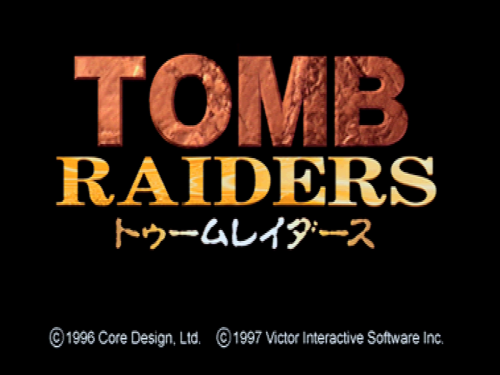
The rather bland Japanese title screen image.
Tomb Raider was designed to run at 30fps and while the Saturn version can’t quite hold a stable 30fps it got pretty close in our non-combat comparison with the PC version. Being about eight frames behind, in a twenty five second run comparison video at 60hz. This is just based on one test so far, but we plan to do more and provide the details in a superior attack video at a later date.
(Note, we should stress that attract/demo mode sections should not be used for frame rate tests, as these sections are often videos or unique sections designed to showcase the best of the game. Often there can have a bit of underhand trickery going on with them, as they are designed to be shown to consumers in shops.)
While the Saturn game engine doesn’t appear to have been improved much for the NTSC/J version, there are numerous art changes and bug fixes. That have occurred, the first one I’m going to highlight is the added loading image of Lara in a dress included after selecting the gym, it appears after the FMV intro to the house.
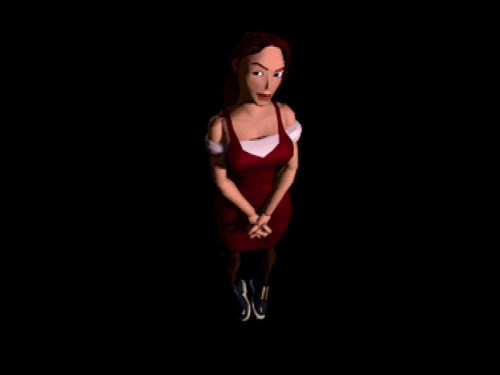
A rare chance to see Lara in her non adventure attire, not seen in the PAL Saturn version.
Next up we have a clear, art bug fix seen in the music room, in the PAL version there is an incorrect over lapping set of strings, incorrect placed upside down. In the Japanese NTSC/J version this has been fixed.
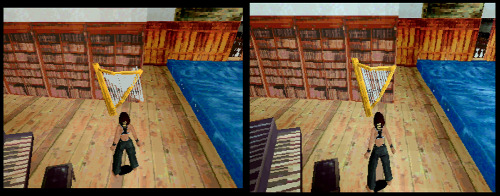
Bug fix to the harp in the music room PAL (Left) NTSC/J (right)
One improvement you might not easier notice without a stop watch is loading times. The NTSC/J version at 60hz, when compared with the PAL version forced into 60hz, loading into and out of scenes a few seconds quicker. So in that area some optimisation has taken place to improve the games performance.
One of the big changes Randomised Gaming spotted is that the PAL version doesn’t use final texture art. In the opening stage alone extra snow and touch ups to the rock textures can be seen in the NTSC/J disc which matches the PC release. Take a look at this images, two from the Saturn and one from the PC version. The grey rock to the far right of Lara has added snow as does the big rock just to her left, in the PAL version there is a dull grey patch where much of the snow was added. All this extra snow is included in the PC version.

PAL (Top) NTSC/J
(Mid) PC (Bottom) the added snow in the NTSC/J version is easy to miss, but is just one of many texture changes.
Now here comes the real last revelation (forgive the Tomb Raider name pun) if you are playing the console ports. As neither the PAL or NTSC console version is running the game correctly. Tomb Raider was designed to run at 30fps, something only NTSC consoles can do, due to the game’s speed not being correct optimised at 50hz. However, the screen aspect ratio was only optimised at 50hz/576i as more of the screen is displayed in each frame. The NTSC version at 480i crops the picture and makes Lara appear stretched at 60hz as a result. (This, 576i optimisation is also why NTSC owners should not purchased the PAL version. As at 60hz the PAL version camera cuts off the bottom of the picture. The NTSC/J version has the camera position adjusted to correct for this issue.)
To demo this, here is the aspect ratio seen on the gym floor at both 50hz PAL on the left and the NTSC/J 60hz. More of the floor tiles both top and bottom can be seen in the PAL release compared to the NTSC version. The same is true with all the previous screenshots shown in this blog post.

PAL 576i Saturn (Left) NTSC/J 480i Saturn (right) the NTSC version looks very zoomed in and the floor titles are no longer true squares. Note how in the NTSC picture it can only show five tiles from top to bottom. Where as the PAL version is almost able to show six fully.
Here’s some more comparison screenshots to show the height of Lara with the PC version, note how in the NTSC screenshot she is in fact taller than her PC counter. That’s because the aspect ratio is incorrect in the NTSC version due to it being badly stretched. Also note how much of the top and bottom of the picture is missing in the NTSC screenshot.

The PAL Saturn
version uses a matching aspect in line with the PC release, compared
to the stretched looking Lara in the NTSC picture. Left PAL Saturn, Middle PC and right Saturn NTSC.
Now, you might be wondering what this all means, well applying my own industry experience and having read as many old interviews with the team behind the game. It’s clear Tomb Raider was rushed and unfinished on the Saturn. In fact, it’s very likely that if you are playing the Saturn version, you aren’t playing a version of the game the developers intended to release.
To me, it looks like the later NTSC builds, just patched the final PAL Saturn code, without adding in some of the improvements seen in the game engine on the PlayStation or PC. The big exception to this rule, is the art textures, they have been completely overhauled for the NTSC/J Japanese version.
In a somewhat odd twist of fate neither the PlayStation or PC versions are quite the definitive versions either. Now this is still early research, but having spent a few hours comparing the early levels in the game. The PC version is the best version these days, not least thanks to some of the nice mods you can get for it. Even if they still don’t add in some of the Saturn and PlayStation exclusive effects. The PlayStation version also has its own unique set of issues not seen in the Saturn.
It like the Saturn version was also clearly designed to display at 576i, but it also incorrectly stretches some textures, much like the square floor in Lara house, which in the PlayStation version isn’t square in either PAL or NTSC. It doesn’t take much to note that many textures in the PlayStation release also appear distorted or incorrect at an angle even the flooring.Lets run that field of view comparison test again.

(Left) PAL Saturn 50hz 576i (Right) PAL PlayStation
50hz 576i. While the PAL PlayStation field of view is more than the NTSC Saturn version, it’s still quite a bit shorter than the PAL Saturn. There also not quite true squares either on PlayStation.
The PlayStation version also has trouble keeping textures straight when drawn at a perspective angle as shown here. Observe the wall to the left of the window and the zigzag look of the wooden panels on it, compared to the ones seen in the Sega Saturn version.
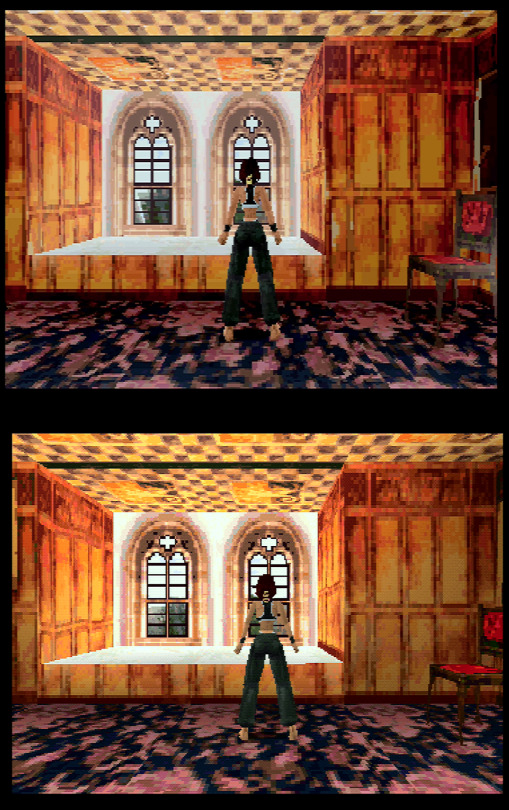
NTSC Saturn (Top) PAL PlayStation (Bottom)
While the PlayStation has sharper textures overall this is mainly the case in the mid range field of view. Up close you can see it adds a mesh effect to them and at distance, textures lose their detail hence the PlayStation version has a smaller draw distance, as you can see below. Look at how the flooring fades out on the PlayStation screen capture.
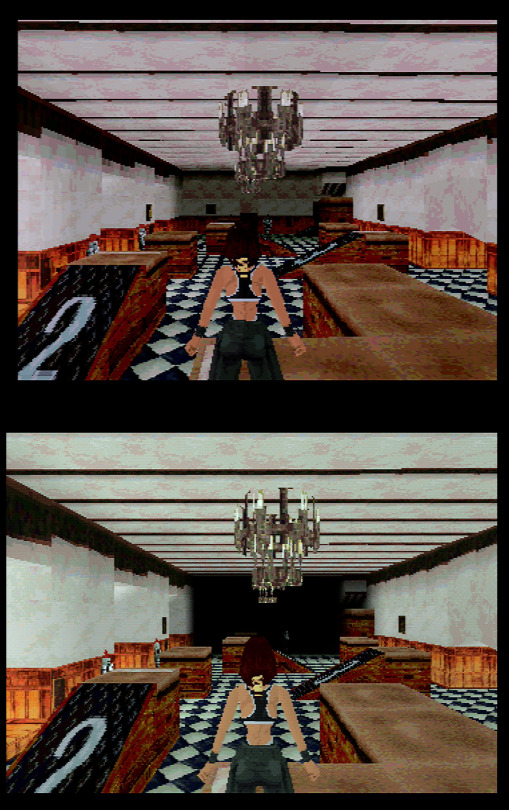
Two comparison of the
draw distance between PAL Saturn (Top) PAL PlayStation (Bottom). Same again for the one below, you can’t see into the music room on PlayStation.

Currently trying to find a truly objective and good quality comparison on Tomb Raider is just impossible on the net. The Saturn and PlayStation rivalry still lingers on even now 20 years later and it shows in comments, videos and just about every news post on the internet, par this one I hope. The other huge problem is the amount of people using emulators to compare games, which doesn’t reflect the performance of games on original hardware.
Our early performance tests also raised some interesting results between the Saturn and PlayStation version. All I’ll say for now is the Saturn version suffers from slowdown noticeably when AI enemies are present or with rapid movement of the camera. Neither of which the PlayStation has an issue with, giving it a more stable frame rate. While the Saturn has a more unstable frame rate, it also runs at a higher frame count, making it the fastest of the two versions when slowdown doesn’t rear its head. This is what I saw when I compared both PAL versions at 50hz on “real hardware” and I must stress the real part.
Shading and colours also differs between the two console versions, Saturn uses a darker palette compared to the PlayStation version, the lighting also differs between the two in many areas. As with other areas we noticed the PAL and NTSC/J Saturn releases use different palette to one another, the NTSC/J seemed to use a slightly lighter palette in some areas. At first I did wonder if it was just a bug with my capture unit settings, but the more screen grabs I took the more I realised that there had been changes between the two.
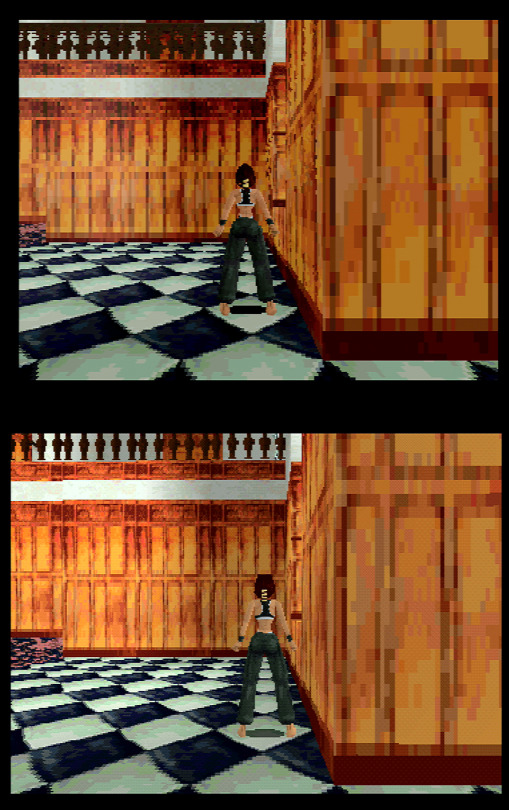
Quick level of detail test at short and middle range, while the
Saturn has the edge at the long range. PlayStation clearly looks better
at the mid range, the more commonly used range. As for the near range
both look almost the same. PAL Saturn (Top) PAL PlayStation (Bottom)
That’s all I’m going to cover for now until we can get a full on video comparison done. There are many other areas the Saturn and PlayStation differ on, already listed over the net. Yet, Lara does have one last secret to tell us, you see it’s not just the PAL Saturn version that was incomplete. Now I know traditional PC versions are usually the last version to be mastered for release. Console games have to be mastered much earlier, as they have to also pass Sega’s and Sony’s internal testing, something you don’t have to do for PC titles. (On that note as a bit of trivial the PAL Saturn release incorrectly uses an image of a Japanese joypad, grey with blue button, the NTSC/J is the flip of that as it uses the western black pad instead.)
Now normally due to
this the PC release often ends up being the final code and art, it’s
a good rule of thumb, but not always so. In Tomb Raider’s case this
seemed to be so, based on the improved textures seen in this version.
These days thanks to mods, you can also run the PC version in lovely
16:9 at 1080p. So time wise if you also include the ATI patch in 1997
it is the last build of the game that got an update.
That why I’m using the PC version as the end point of this next screenshot comparison, so first will be the PAL Sega Saturn which was the first build released and according to the header file on the disc was mastered on the 17th September 1996. Followed by the PAL PlayStation one which released in late November 1996, so mastered around the end of October and third will be the Japanese Saturn release with a header build of 26th November 1996.
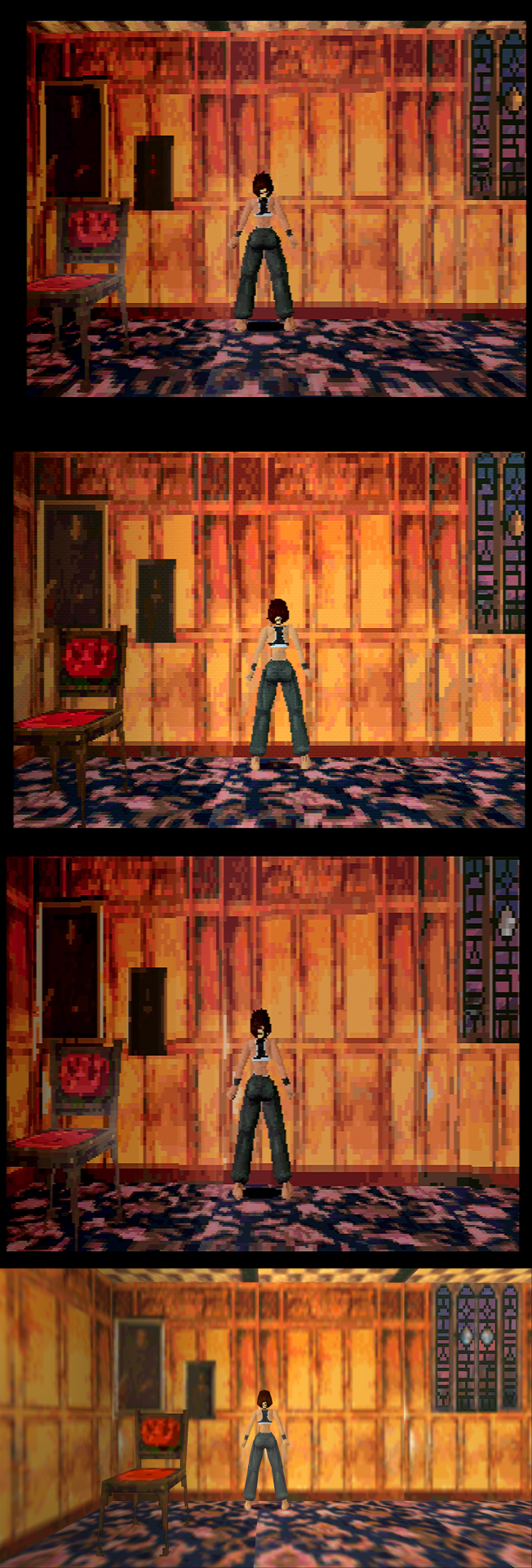
Ignoring the fact
that the PC version is in widescreen and that the Japanese NTSC
Saturn release looks stretched can you spot the texture changes? The
key areas to look at are the chair, stained glass in the window,
pictures frame and wall texture. Order again is, PAL Saturn, PAL PlayStation, NTSC/J Saturn and PC.
The PAL Saturn version is the only one to have the dark red texture on the left side of the back of the chair’s red padding, in every other version it is flipped so appears on the right. The wood texture used on the chair is also different from other versions. In the two PAL console versions the stained glass window is a muddy brown like the frame it sits in. Where in the NTSC/J Saturn one it is a grey, the PC version adds in some blue with the grey. Both the PC and NTSC Saturn versions have recoloured picture frames and touched up wood panelling with a white highlight on some walls. There are a few other changes also, but that is a clear timeline of art fixes and changes to Tomb Raider.
Remember when I said it up opened a can of worms early here’s the thing, based on this evidence, none of the PAL console versions use the final build of the game. While I wasn’t able to source a NTSC/U copy of the Saturn version, I was able to look at the last American PlayStation version. That had all the same colouring and textures as the PAL PlayStation release from what I tested. We weren’t able to find a Japanese PlayStation version either, but as Victor published it the same time as the Saturn release. The fixes seen in the Japanese Saturn version are likely to be includes in the Japanese PlayStation release as well.

Lara’s handstand move which doesn’t appear in any version of the game on Sega Saturn
Now while we can’t say for certain until someone tests every version released in Europe and American. As the Platinum or Greatest hit versions might be different, it appears the fixes added to the Japanese release, weren’t then added into any of the later western releases on PlayStation. I can say for certain the PAL Saturn re-release in the DVD hard case, was just the original Saturn version with no added fixes. As Randomised Gaming has both PAL boxed versions one is from print pressing B the other from G. The only change is the case it came in and an additional number code printed on the disc rim.
Which on a bit of a bombshell note means that if you live in the west and played Tomb Raider on console you likely have never played the final version of the game, Core Design wanted to give to gamers in the 90s. OK, that’s a bit of a sweeping, without us check every version released, but the evidence isn’t looking good.
As is often the case the last version out the door of the studio, is the best patched up release which is why for a British developed game the Japanese console version is the best looking. Strangely the same often happens with the European version of Japanese games as the PAL version tended to be developed last.
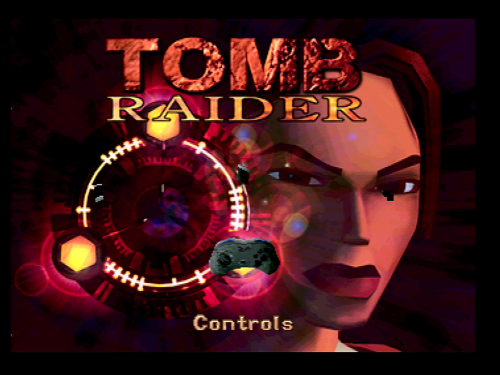
The Japanese Sega Saturn joypad cameo’s in the PAL version
Ultimately it leaves me with a lot more questions, such as how does the rest of the game compare between versions seeing as so far, I’ve only tested the early levels. It’s been over a decade since I last finished the game and I’ve only just starting working through the NTSC/J release for the first time. To me applying my industry experience and the tight time frame it’s been said, they build the game in, it couldn’t have been an easy development. As many of these changes showed the developers kept trying to make the game better with every release, up until development finally stopped. Certainly having looked at the various versions myself this past week, there’s are now a few burning questions I’d like to ask the team if I could.
As for our final verdict on the Saturn version, it’s clear the games has been improved for the NTSC/J release in many areas when directly compared with the PAL release. This comes at the cost of an incorrect aspect ratios, but the improvements are worth this trade off. While many of the changes aren’t easily noticeable and there is no clear evidence of a an frame rate improvement when both versions are run at 60hz. The amount of improvements to textures, load times, cartridge support, bug fixes make the NTSC/J the version of choice for Saturn owner.
Is it worth upgrading, if you own the PAL version or NTSC/U already? That really depends how much a fan you are of the series and if you plan on playing the game again. It’s far to say that many of these changes most users wouldn’t notice unless they are directly pointed out to them. However, for the best version it’s far to say, grab the steam release and look into some of the fan mods.
That’s it I hope you’ve enjoyed this short look at some of the changes between the Saturn versions and are insight into some of the other releases and changes. We will aim to a more in depth video on the subject at a later date, but for now I need to look into the Japanese PlayStation version.
For high resolution of many of the comparison images used in this feature please visit these two image blog post here and here. They make comparing some of the changes much easier. You can also see are video look here:
Feature by Random Gamer Riven.
Twitter: RDGamerRiven
E.mail: randomgamerriven@gmail.com








